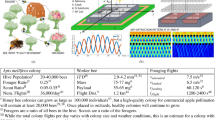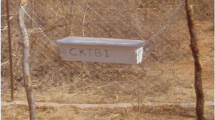Abstract
Social pollinators are a critical part of both natural and agricultural ecosystems, and a great source of inspiration for engineered swarms. Recently, researchers have produced a range of systems for automated monitoring of honey bee entrances to further insights on e.g. collective foraging, labor distribution, and suppression of disease transmission. In this article, we detail the design of a system customized for capturing top and side view photos of bumble bees as they enter and exit their hives. We show how these photos can be used to automatically track foraging activity, identify individuals, and characterize bee size and pollen presence. To aid technology adoption by biologists, our design is specifically optimized for low cost and easy fabrication, operation, and maintenance. Over two iterations, the entrance has been used on 8 hives in greenhouse and field over 10 weeks.




Similar content being viewed by others
References
McArt SH, Urbanowicz C, McCoshum S, Irwin RE (2017) Landscape predictors of pathogen prevalence and range contractions in US bumblebees. Proc R Soc B Biol Sci 284(1867):20172181
Abdel-Raziq HM, Palmer DM, Koenig PA, Molnar AC, Petersen KH (2021) System design for inferring colony-level pollination activity through miniature bee-mounted sensors. Sci Rep 11(1):1–12
Gallai N, Salles JM, Settele J, Vaissière BE (2009) Economic valuation of the vulnerability of world agriculture confronted with pollinator decline. Ecol Econ 68(3):810–821
Jiang JA, Wang CH, Chen CH, Liao MS, Su YL, Chen WS, Chuang CL (2016) A WSN-based automatic monitoring system for the foraging behavior of honey bees and environmental factors of beehives. Comput Electron Agric 123:304–318
Bjerge K, Frigaard CE, Mikkelsen PH, Nielsen TH, Misbih M, Kryger P (2019) A computer vision system to monitor the infestation level of Varroa destructor in a honeybee colony. Comput Electron Agric 164:104898
Tu GJ, Hansen MK, Kryger P, Ahrendt P (2016) Automatic behaviour analysis system for honeybees using computer vision. Comput Electron Agric 122:10–18
Ngo TN, Wu KC, Yang EC, Lin TT (2019) A real-time imaging system for multiple honey bee tracking and activity monitoring. Comput Electron Agric 163:104841
Chiron G, Gomez-Krämer P, Ménard M (2013) Detecting and tracking honeybees in 3D at the beehive entrance using stereo vision. EURASIP J Image Video Process 1:1–17
Gil-Lebrero S, Quiles-Latorre FJ, Ortiz-López M, Sánchez-Ruiz V, Gámiz-López V, Luna-Rodríguez JJ (2017) Honey bee colonies remote monitoring system. Sensors 17(1):55
Cecchi S, Spinsante S, Terenzi A, Orcioni S (2020) A smart sensor-based measurement system for advanced bee hive monitoring. Sensors 20(9):2726
Tashakkori R, Hernandez NP, Ghadiri A, Ratzloff AP, Crawford MB (2017) A honeybee hive monitoring system: from surveillance cameras to Raspberry Pis. In: SoutheastCon 2017, pp 1–7. IEEE
Rodriguez IF, Megret R, Acuna E, Agosto-Rivera JL, Giray T (2018) Recognition of pollen-bearing bees from video using convolutional neural network. In: 2018 IEEE winter conference on applications of computer vision (WACV), pp 314–322. IEEE
Crall JD, Gravish N, Mountcastle AM, Combes SA (2015) BEEtag: a low-cost, image-based tracking system for the study of animal behavior and locomotion. PLoS One 10(9):e0136487
Wang J, Olson E (2016) AprilTag 2: efficient and robust fiducial detection. In: 2016 IEEE/RSJ international conference on intelligent robots and systems (IROS), pp 4193–4198. IEEE
Acknowledgements
The work was funded by the National Science Foundation and the United States Department of Agriculture Grants #1739671 and #137536, a Research Innitiative Funding grant from the Cornell Institute for Digital Agriculture 2019, and a Cornell Engineering Learning Initiatives Grant. The authors would also like to thank Marta Kimmel, Timothy Salazar, and Phoebe Koenig for their early contributions to this work.
Author information
Authors and Affiliations
Corresponding author
Additional information
Publisher's Note
Springer Nature remains neutral with regard to jurisdictional claims in published maps and institutional affiliations.
This work was presented in part at the joint symposium with the 15th International Symposium on Distributed Autonomous Robotic Systems 2021 and the 4th International Symposium on Swarm Behavior and Bio-Inspired Robotics 2021 (Online, June1–4, 2021.
About this article
Cite this article
Du, J., Brothers, Z., Valdes, L. et al. Automated entrance monitoring of managed bumble bees. Artif Life Robotics 27, 278–285 (2022). https://doi.org/10.1007/s10015-022-00748-9
Received:
Accepted:
Published:
Issue Date:
DOI: https://doi.org/10.1007/s10015-022-00748-9




